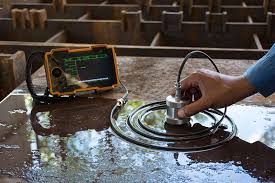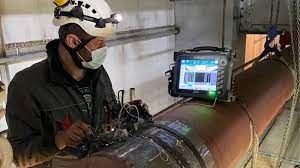Turbine blade ultrasonic inspection has seen significant advancements in Egypt in recent years. As the demand for efficient and reliable turbine blades continues to grow, the need for advanced inspection techniques has become increasingly important. In this paper, we will explore the latest developments in turbine blade ultrasonic inspection in Egypt and the impact it has had on the industry.
Advancements in turbine blade ultrasonic inspection in Egypt have seen the development of advanced non-destructive testing techniques for identifying defects such as cracks and delaminations in turbine blades. These techniques involve the use of high-frequency ultrasonic waves to detect and analyze internal flaws within the blades, allowing for more accurate and reliable inspections. Additionally, advancements in imaging and data analysis technology have improved the efficiency and accuracy of these inspections, ultimately leading to enhanced turbine blade performance and longevity. These advancements have been instrumental in ensuring the safety and reliability of turbine blades in Egypt's growing energy sector.
Advancements in Turbine Blade Ultrasonic Inspection in Egypt

Advancements in turbine blade ultrasonic inspection in Egypt have significantly improved the accuracy and efficiency of detecting defects and ensuring the structural integrity of the blades. This technology uses high-frequency sound waves to penetrate the blade material and detect any flaws or abnormalities that may compromise its performance. The implementation of advanced equipment and techniques has enhanced the ability to conduct thorough inspections, leading to increased safety, reliability, and longevity of turbine blades in the country's power generation and aerospace industries. These advancements have also contributed to minimizing downtime and maintenance costs, ultimately improving the overall operational efficiency of turbine systems.
The Role of Ultrasonic Technology in Egypt's Turbine Blade Industry

Ultrasonic technology plays a crucial role in Egypt's turbine blade industry. This technology is used for the non-destructive testing of turbine blades to detect any potential flaws or defects. By using ultrasonic waves, technicians are able to penetrate the material of the turbine blades and accurately identify any imperfections that could compromise the integrity of the blades. Furthermore, ultrasonic technology is also utilized in the manufacturing process of turbine blades. It helps in ensuring the precise dimensions and structural integrity of the blades, leading to improved performance and longevity of the turbines. This technology has significantly contributed to the quality control of turbine blades in the Egyptian industry, meeting international standards and specifications. In addition, the implementation of ultrasonic technology has enhanced the overall efficiency of the turbine blade production process in Egypt. It has allowed for quicker and more accurate inspections, resulting in reduced downtime and higher productivity. As a result, the use of ultrasonic technology has become increasingly important for the growth and competitiveness of Egypt's turbine blade industry.
Challenges and Solutions for Turbine Blade Ultrasonic Inspection in Egypt

Challenges in turbine blade ultrasonic inspection in Egypt include limited access to technical expertise and specialized equipment, as well as the high cost of implementing advanced inspection technologies. Additionally, the harsh environmental conditions in some regions can also pose challenges for effective inspection. Solutions to these challenges may involve investing in training programs for technicians and engineers to enhance their inspection capabilities, as well as collaborating with international firms to access state-of-the-art inspection equipment. Furthermore, developing strategic partnerships with local research institutions and industry experts can help address the specific challenges related to environmental conditions and maintenance of turbine blades in Egypt.
The Future of Turbine Blade Ultrasonic Inspection in Egypt
ultrasonic testing of welds
The future of turbine blade ultrasonic inspection in Egypt looks promising with advancing technology and increased focus on renewable energy sources. The use of advanced ultrasonic techniques such as phased array and guided wave inspection is becoming more prevalent in the country's power generation industry. These advanced techniques offer greater accuracy, faster inspection times, and improved defect detection capabilities compared to traditional methods. Additionally, the growing emphasis on energy efficiency and environmental sustainability is driving the need for more reliable and effective inspection methods for turbine blades. Furthermore, the government's initiatives to expand and modernize the country's power infrastructure, including wind and solar power projects, are expected to create a greater demand for turbine blade inspection services. This will likely lead to further advancements in ultrasonic inspection technology and methodologies in Egypt. Overall, the future of turbine blade ultrasonic inspection in Egypt seems bright, with the potential for increased adoption of advanced techniques and technologies to support the country's evolving energy landscape.
Understanding the Importance of Ultrasonic Inspection for Egypt's Turbine Blades<
ultrasonic testing of welds/h2>
Ultrasonic inspection is crucial for Egypt's turbine blades as it helps to detect any potential defects or damages that could compromise the performance and safety of the turbine. This non-destructive testing method allows for thorough and precise examination of the internal structure of the blades, ensuring that any flaws are identified and addressed before they escalate into costly and catastrophic failures. By regularly conducting ultrasonic inspections, Egypt can maintain the reliability and efficiency of its turbine blades, ultimately prolonging their lifespan and minimizing the risk of unexpected breakdowns. This proactive approach to maintenance is essential for ensuring the consistent and uninterrupted operation of Egypt's power generation facilities.
Improving Safety and Efficiency Through Ultrasonic Inspection in Egypt
Improving safety and efficiency through ultrasonic inspection in Egypt involves using advanced technology to assess the integrity of industrial equipment, machinery, and infrastructure. This non-destructive testing method utilizes high-frequency sound waves to detect flaws and defects that may compromise the safety and performance of critical assets. By implementing ultrasonic inspection, companies in Egypt can proactively identify and address potential issues, reduce the risk of equipment failure, and optimize maintenance processes. This ultimately leads to improved safety, increased operational efficiency, and cost savings in the long run. Additionally, ultrasonic inspection can help organizations in Egypt comply with industry regulations and standards, ensuring that their facilities meet the necessary safety requirements.
Implementing Best Practices for Turbine Blade Ultrasonic Inspection in Egypt
Implementing best practices for turbine blade ultrasonic inspection in Egypt involves adopting advanced ultrasonic testing techniques and equipment to ensure the reliability and safety of turbine blades. This includes implementing standardized inspection procedures, training personnel in the use of ultrasonic testing equipment, and following industry guidelines for detecting and evaluating potential defects in turbine blades. By employing these best practices, the efficiency and performance of turbine blades can be maximized, reducing the risk of unexpected failures and downtime. Furthermore, adopting these best practices can improve the overall safety and reliability of turbine systems in Egypt.